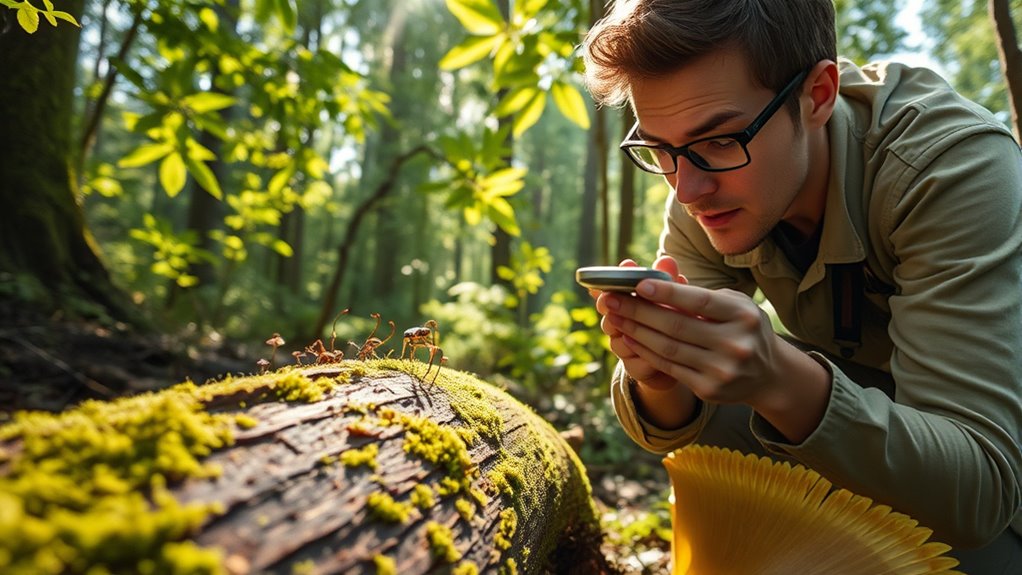Citizen scientists discover new species by using smartphones, cameras, and online platforms to document and share their findings globally. They photograph unfamiliar organisms, often collaborating with professionals who help identify and confirm these discoveries. Social media allows amateurs to showcase rare or unknown species, leading to formal scientific descriptions. Their passion and advanced tools are expanding biodiversity knowledge, proving that anyone can contribute to discovering Earth’s hidden species—if you want to know more, stay with us.
Key Takeaways
- Citizen scientists document unknown organisms through photographs and observations shared on social media and online platforms.
- Collaboration between amateurs and professionals enables identification and formal description of new species.
- Advanced validation techniques and standardized protocols ensure the accuracy of citizen-collected data.
- Smartphones and GIS tools facilitate precise documentation, aiding in the discovery of previously unrecorded species.
- Long-term citizen science projects generate extensive biodiversity records, increasing chances of detecting new species over time.

Citizen scientists are playing an increasingly essential role in discovering new species and expanding our understanding of biodiversity. Thanks to their efforts, last year they contributed to over 9.6 million out of 10 million species observations, demonstrating how crucial their work has become. While some concerns about data reliability exist, pairing citizen science with professional research helps guarantee accuracy, making these contributions highly valuable. Enthusiast communities, such as birders, often drive these projects, motivated by passion and curiosity. Long-running initiatives benefit from consistent data collection, creating extensive records that help scientists track and analyze species over time.
Citizen scientists contribute millions of species observations annually, vital for biodiversity research and discovery.
Modern technology, especially smartphones, has revolutionized how citizen scientists gather and share data. With just a few taps, you can record sightings, take photographs, and upload information to online platforms. This ease of use broadens participation and allows for rapid data collection across diverse environments. In Australia, for example, nearly half of all species observations documented in the Atlas of Living Australia come from citizen contributions. Birds are particularly well-documented; common species like the Australian magpie are recorded frequently, but citizen science is especially effective for monitoring rare or threatened species, where even a few sightings can provide critical insights.
Citizen science isn’t limited to terrestrial environments. It plays a significant role in marine biodiversity studies, where over 242,000 known species inhabit complex ecosystems like reefs. These projects often involve annual surveys of fish and reef species, with volunteers helping to monitor changes and identify new or elusive species. Collaboration with professionals enhances the reliability of marine data, enabling more accurate assessments of ecosystem health. Observations from citizen scientists have been instrumental in tracking shifts in marine populations, especially as climate change impacts these environments. Recent advancements in data validation techniques further improve the accuracy of citizen-collected information, fostering greater confidence in their contributions. Additionally, the development of standardized protocols is helping to improve the consistency of data collected across different projects.
One of the most exciting aspects of citizen science is its role in discovering new species. Social media platforms enable amateur photographers to share striking images of unfamiliar organisms. When these photos are posted, professional researchers can sometimes identify previously unknown species, especially when combined with other data. Such collaborations often lead to formal scientific descriptions of new species. The global reach of social media allows amateurs worldwide to contribute, providing early hints of discoveries that might otherwise go unnoticed.
Tools like smartphones, cameras, and geographic information systems (GIS) facilitate visual documentation and precise mapping of species distributions. These technologies empower citizen scientists to make meaningful contributions. Despite some skepticism about data quality, rigorous validation processes and standardized methods are improving confidence in citizen-collected data. Moving forward, ongoing collaboration between amateurs and professionals will continue to uncover new species and deepen our understanding of Earth’s biodiversity, making citizen science a cornerstone of modern discovery.
Frequently Asked Questions
How Do Citizen Scientists Get Trained to Identify New Species?
You get trained through a mix of online videos, guides, and interactive tools that teach you how to identify species accurately. Many programs include mentorship from experts, and you can learn on the job with in-project training. Apps and digital platforms help you collect data and learn as you go, boosting your confidence and data quality. This extensive approach makes it easier for you to contribute meaningful discoveries.
What Equipment Do Citizen Scientists Typically Use for Discoveries?
You typically use a variety of equipment for discoveries, including smartphones and digital cameras to capture images, GPS devices to mark locations, and mobile apps like EASIN for reporting invasive species. Traps help collect insects, while underwater cameras and microscopes assist in studying marine life and small specimens. Data loggers and storage equipment preserve environmental info and samples, making it easier for you to analyze and share your findings effectively.
How Are New Species Officially Recognized and Named?
Imagine revealing a hidden treasure, and that’s how new species are officially recognized and named. You must submit your discovery to scientific journals, where peer review acts as the gatekeeper. Once approved, taxonomic boards validate your work, and a Latinized, unique name is assigned, respecting cultural sensitivities. This process guarantees your discovery is cataloged in the global biological library, securing its place in nature’s story.
What Challenges Do Citizen Scientists Face During Discoveries?
You face several challenges during discoveries as a citizen scientist. Maintaining motivation over time can be tough, especially without immediate recognition. Ensuring data quality is critical, so providing clear instructions and validating your findings with experts matter. Spatial and taxonomic biases may limit diversity, and project logistics like funding and coordination can be obstacles. Despite these, your participation helps expand scientific knowledge, making your efforts valuable and impactful.
Can Citizen Scientists Contribute to Conservation Efforts After Discovery?
You can definitely contribute to conservation efforts after discovering a new species. By sharing your findings through platforms like iNaturalist or collaborating with experts, you help inform conservation strategies. Your data can influence threat assessments, aid in protecting habitats, and update global lists like the IUCN Red List. Staying involved guarantees your discovery leads to meaningful action, supporting the species’ survival and broader ecosystem health.
Conclusion
As a citizen scientist, you’re like a detective uncovering hidden treasures in nature’s vast puzzle. Your discoveries help scientists understand our world better and protect its fragile ecosystems. Every new species you find is like a piece of a giant jigsaw puzzle finally falling into place. So, keep exploring with curiosity and passion—because, just like a brave adventurer, you have the power to reveal wonders that might otherwise stay hidden forever.










